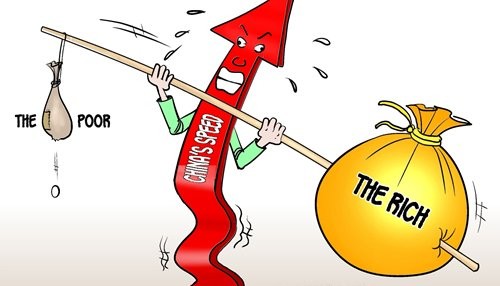Economic Inequality: Causes, Consequences, and Solutions

Economic inequality refers to the unequal distribution of wealth, income, and resources within a society or between different countries. It manifests in disparities in wages, access to education and healthcare, and ownership of assets like property and stocks. Economic inequality has become a significant global issue, shaping the lives of millions and influencing social, political, and economic systems. While some level of inequality is natural in any society, extreme inequality can have far-reaching negative consequences for individuals, communities, and the global economy.
In this article, we will explore the causes of economic inequality, its impact on society, and potential solutions for reducing the gap between the rich and the poor.
Causes of Economic Inequality
Economic inequality arises from a combination of factors, including differences in individual skills, education, access to resources, and the economic systems that govern societies. Here are some of the main causes:
- Educational Disparities: Education is one of the key determinants of an individual’s earning potential. People with access to quality education, particularly higher education, often have better job prospects and higher incomes. In contrast, those with limited access to education tend to remain in lower-paying jobs, perpetuating the cycle of poverty.
- Technological Advancements: Technological progress, while driving economic growth, has also widened the income gap. Automation, artificial intelligence, and other technological innovations have replaced many low-skill jobs, while creating high-paying jobs in tech and finance sectors. This shift disproportionately benefits those with advanced skills, leaving behind those in lower-skilled or manual labor positions.
- Globalization: Globalization has led to the integration of economies and increased trade and investment flows. While it has lifted many people out of poverty in developing countries, globalization has also contributed to rising inequality. Wealthier nations and individuals have benefitted from access to global markets, while workers in certain industries have seen job losses and stagnant wages due to outsourcing and competition.
- Labor Market Dynamics: The structure of labor markets influences wage distribution. In many countries, stagnant wages, declining union memberships, and labor market policies that favor employers over workers have contributed to rising income inequality. In addition, the gig economy and part-time work often provide less job security and lower wages, further exacerbating the income gap.
- Tax Policies and Wealth Concentration: Inequality is often fueled by tax policies that favor the wealthy. In many cases, the rich are able to take advantage of tax loopholes, lower capital gains taxes, and offshore accounts, allowing them to accumulate and preserve wealth. In contrast, middle- and lower-income individuals often bear a higher tax burden relative to their earnings.
- Inheritance and Wealth Transfer: Wealth inequality is perpetuated across generations through inheritance. The children of wealthy families often have access to better education, healthcare, and financial resources, giving them an advantage over others. Inherited wealth contributes significantly to the concentration of wealth among a small segment of the population.
- Discrimination and Social Barriers: Gender, race, and ethnicity can also play a role in economic inequality. Systemic discrimination can limit access to education, employment opportunities, and fair wages for certain groups, leading to income disparities. Women, for instance, continue to face wage gaps compared to men in many parts of the world.
Consequences of Economic Inequality
Extreme economic inequality has wide-ranging consequences that affect not just those at the bottom of the income scale but society as a whole. Some of the most significant impacts include:
- Social and Political Instability: High levels of inequality can lead to social unrest, political instability, and increased crime rates. When a significant portion of the population feels excluded from economic opportunities, tensions rise, leading to protests, political upheavals, and, in extreme cases, revolutions.
- Reduced Economic Growth: Inequality can hinder overall economic growth. When wealth is concentrated in the hands of a few, consumption is limited to those individuals, whereas a more equitable distribution of income would lead to increased spending by a broader segment of society, driving economic growth. Moreover, inequality can limit access to education and healthcare, reducing the productivity of the workforce.
- Health Disparities: Economic inequality leads to unequal access to healthcare services. Wealthier individuals can afford better medical care, leading to longer life expectancy and better health outcomes, while those in lower-income brackets often face challenges in accessing quality healthcare. This disparity contributes to a cycle of poor health and poverty.
- Educational Inequality: The wealth gap often translates into unequal access to quality education. Children from wealthier families have access to better schools, tutoring, and extracurricular opportunities, giving them an edge in the job market. Meanwhile, children from low-income families may struggle to complete their education or attend underfunded schools, limiting their future economic mobility.
- Erosion of Trust in Institutions: When economic inequality becomes extreme, public trust in institutions—such as the government, legal system, and financial markets—tends to decline. People may feel that these institutions favor the wealthy and powerful, leading to a loss of faith in democracy and the rule of law.
- Environmental Impact: Inequality can exacerbate environmental degradation. Wealthy individuals and corporations are often the largest consumers of resources and contributors to pollution, while poorer communities suffer the brunt of environmental damage, such as poor air quality and lack of access to clean water. In many cases, the poorest people are forced to live in areas most affected by environmental disasters, further entrenching inequality.
Solutions to Economic Inequality
While economic inequality is a complex and multifaceted issue, there are several strategies that governments, institutions, and individuals can adopt to address it. These solutions involve promoting fairer distribution of wealth, expanding access to opportunities, and fostering social mobility.
- Progressive Taxation: Implementing progressive tax policies can help reduce inequality by ensuring that the wealthiest individuals and corporations contribute a fair share of their income to public resources. This can be used to fund social services such as education, healthcare, and welfare programs that benefit the entire population.
- Access to Quality Education: Expanding access to quality education for all is one of the most effective ways to reduce inequality. Governments should invest in public education, providing scholarships, financial aid, and affordable schooling options to ensure that individuals from all economic backgrounds have the opportunity to succeed.
- Universal Healthcare: Access to healthcare should not be a privilege reserved for the wealthy. Implementing universal healthcare systems ensures that everyone, regardless of income, has access to the medical services they need, reducing health disparities and improving overall quality of life.
- Labor Market Reforms: Strengthening labor rights, raising the minimum wage, and ensuring equal pay for equal work can help reduce income inequality. Encouraging union membership and collective bargaining can also help workers negotiate for better wages and working conditions.
- Social Safety Nets: Governments should establish or expand social safety net programs, such as unemployment benefits, pensions, and housing assistance, to provide a safety cushion for those in need. These programs can help reduce poverty and prevent economic shocks from pushing people into extreme financial hardship.
- Wealth Redistribution Policies: In addition to progressive taxation, policies aimed at redistributing wealth, such as wealth taxes or inheritance taxes, can help curb the concentration of wealth in the hands of a few. These policies can be used to fund public services and infrastructure projects that benefit all citizens.
- Combatting Discrimination: Addressing systemic discrimination in hiring practices, wage structures, and access to education is essential for reducing economic inequality. Governments and organizations must work to eliminate gender, racial, and ethnic barriers in the workforce and create opportunities for all individuals to thrive.
Conclusion
Economic inequality is one of the defining challenges of our time. While it has deep historical roots and is influenced by a wide array of factors, it is not an inevitable outcome of modern society. By implementing policies that promote fairer distribution of wealth, expanding access to education and healthcare, and ensuring equal opportunities for all, we can work toward a more equitable world. Reducing economic inequality is not just about improving individual lives—it’s about creating more stable, prosperous, and just societies for future generations.
For more insights into global issues, social justice, and economic trends, visit ITSparkMedia.


